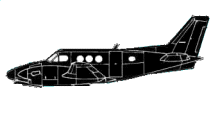
ASN Wikibase Occurrence # 292629
This information is added by users of ASN. Neither ASN nor the Flight Safety Foundation are responsible for the completeness or correctness of this information.
If you feel this information is incomplete or incorrect, you can submit corrected information.
| Date: | Wednesday 15 February 2006 |
| Time: | 15:10 LT |
| Type: |  Beechcraft C90A King Air |
| Owner/operator: | Ulair Aviation, LLC |
| Registration: | N12LE |
| MSN: | LJ-1751 |
| Year of manufacture: | 2005 |
| Total airframe hrs: | 47 hours |
| Engine model: | Pratt & Whitney Canada PT6A-21 |
| Fatalities: | Fatalities: 0 / Occupants: 1 |
| Aircraft damage: | Substantial |
| Category: | Accident |
| Location: | Tampa, Florida -
 United States of America United States of America
|
| Phase: | Unknown |
| Nature: | Ferry/positioning |
| Departure airport: | Miami International Airport, FL (MIA/KMIA) |
| Tampa International Airport, FL (TPA/KTPA) | |
| Investigating agency: | NTSB |
| Confidence Rating: |
The solo airline transport pilot was conducting a VFR positioning flight under Title 14, CFR Part 91, in a twin-engine, turboprop airplane. While on approach to the destination airport, the pilot moved the landing gear control selector to the down position, and he saw a red annunciator warning light, indicting that the right main landing gear was not safe for landing. The pilot then discontinued the approach, and referred to the emergency and abnormal procedures section of the checklist, but noted that he was unable to find any clear direction that pertained to his specific condition. Additionally, he contacted maintenance personnel to request technical assistance, but the technician was unable to offer any additional assistance. The pilot retracted and extended the landing gear three times, but the right main landing gear red annunciator warning light remained on each time. The pilot flew by the local control tower so air traffic control tower personnel, along with maintenance technicians could inspect the landing gear prior to landing. At the completion of the fly by, the pilot was advised that the right main landing gear appeared to be down, and the airplane was cleared to land. After landing, as the airplane's ground roll slowed, the right main landing gear collapsed. The right wing struck the surface of the runway and sustained substantial damage. A postaccident inspection revealed no preaccident mechanical anomalies. The right main landing gear actuator and the right main landing gear downlock switch were removed for additional testing and evaluation, and both functioned properly, with no mechanical anomalies noted. The airplane flight manual, abnormal procedures section, does give instructions for an alternate method of lowering the landing gear by pumping it down by hand until it reaches a locked position, or until maximum system pressure is reached if the down lock light does not illuminate. The pilot did not follow these procedures.
Probable Cause: The collapse of the right main landing gear for an undetermined reason during the landing roll, which resulted in a collision with the runway. A factor contributing to the accident was the pilot's failure to follow the published emergency/abnormal procedures.
Accident investigation:
 |
|
Sources:
NTSB MIA06LA055
Revision history:
| Date/time | Contributor | Updates |
|---|---|---|
| 09-Oct-2022 07:02 | ASN Update Bot | Added |
| 18-Nov-2022 06:44 | Ron Averes | Updated [Aircraft type, Narrative] |
Corrections or additions? ... Edit this accident description
The Aviation Safety Network is an exclusive service provided by:


 ©2024 Flight Safety Foundation
©2024 Flight Safety Foundation